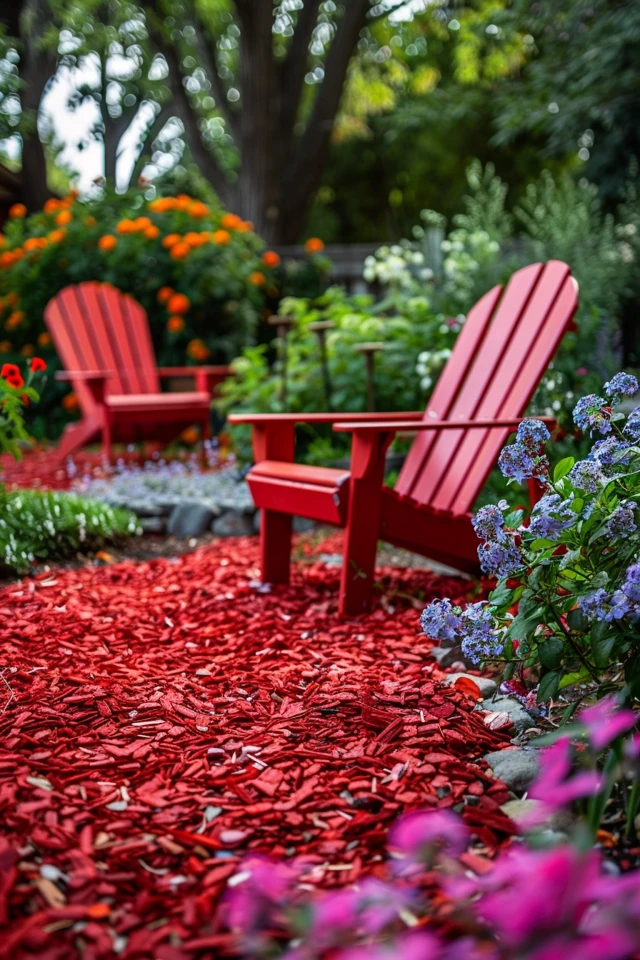Hello there! Are you looking to add a pop of vibrant color to your garden? Look no further than red mulch! Red mulch is a popular choice for landscaping, and today I’m going to share some of my top ideas for incorporating it into your outdoor space. From stunning garden designs to creative outdoor decor, red mulch can transform your landscape into a visual delight.
When it comes to landscaping with red mulch, there’s an array of design options to explore. Whether you want to create a bold and vibrant garden or prefer a more subtle and elegant look, red mulch can be a versatile addition to any outdoor setting.
To inspire your creativity, here are some of the best red mulch landscaping ideas:
- Create a flower bed with red mulch as a border to highlight your colorful blooms.
- Use red mulch as a backdrop for evergreen shrubs to enhance their natural beauty.
- Design a vibrant pathway by lining it with red mulch for a visually striking effect.
- Incorporate red mulch in combination with rocks or stones to add texture and depth to your landscape.
- Add red mulch to your outdoor decor by using it in planters or hanging baskets.
- Experiment with different shades of red mulch to create a multi-dimensional and eye-catching display.
- Opt for creative mulch arrangements, such as geometric patterns or intricate designs, to make a bold statement.
With these red mulch landscaping ideas, you can infuse your garden with warmth and vibrancy. Let your creativity flow and unleash the potential of red mulch in your outdoor oasis. Remember, when it comes to landscaping, the possibilities are endless!

Key Takeaways:
- Red mulch offers a vibrant and eye-catching addition to your garden.
- It can be used to highlight flower beds, evergreen shrubs, and pathways.
- Combining red mulch with rocks or stones can add texture and depth to your landscape.
- Red mulch can also be incorporated into outdoor decor, such as planters or hanging baskets.
- Get creative with different shades and arrangements of red mulch to make a unique statement in your garden.
The Popularity of Dyed Mulch and its Potential Drawbacks
Dyed mulch, including red, black, and brown varieties, has become increasingly popular in landscaping. Big box stores now feature large displays of dyed mulch and offer special sales.
The dyes used in dyed mulch are often made from iron oxide for red and carbon black for black. While these dyes may be labeled as “natural,” there are concerns about their safety and potential toxicity.
Additionally, the wood used in dyed mulch is often waste wood such as pallets and shipping crates, which may have been treated with chemicals.

It is important to consider the potential impacts of dyed mulch on plants, earthworms, soil bacteria, and other organisms in the garden.
As an alternative to dyed mulch, natural wood mulch is recommended for its moisture retention and weed suppression properties.
Dyed mulch may offer vibrant colors and immediate visual impact to a landscape, but it’s essential to understand the potential drawbacks and make an informed decision based on your priorities and concerns.
Landscaping with Rocks: A Low-Maintenance Alternative to Mulch
Landscaping with rocks offers a cost-effective and easy-to-maintain solution that adds natural aesthetics to your outdoor space. By utilizing rocks, such as river rock, you can create stunning rock flower beds that enhance the overall beauty of your landscape.
One of the major advantages of rocks compared to traditional mulch is their longevity. Unlike mulch, which needs to be replaced annually, rocks require minimal upkeep and can withstand the effects of leaf blowers and other outdoor equipment.

In addition to being long-lasting, rocks offer cost savings in the long run. Since they do not need frequent replenishment, you can enjoy the benefits of a beautiful garden without constantly investing in new materials.
When creating rock flower beds, start by preparing the area by removing old plants and excess mulch. Then, lay down landscape fabric to prevent weed growth. Next, carefully place your chosen plants to achieve an aesthetically pleasing layout. Finally, spread the rocks evenly to complete the rock flower bed. For a well-balanced design, you can combine rocks and mulch to create an eye-catching contrast.
Overall, landscaping with rocks provides a durable and low-maintenance option for enhancing the natural beauty of your outdoor spaces. With their cost-effectiveness and ease of maintenance, rock flower beds are an excellent alternative to traditional mulch, giving your landscape a timeless and visually appealing look.

